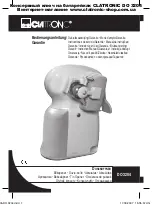
A
dditional
UL
Requirements
• A
minimum of two (2) warning signs shall be installed, one on each side of the gate where easily visible.
• The gate must have sufficient room when opening and closing. Swinging gates should open inwards and
not into public access areas. The gate must be properly installed and move freely in both directions.
•
Install the gate operator only when: 1) The operator is appropriate for the construction of the gate and
the usage Class of the gate, 2) All openings of a horizontal slide gate are guarded or screened from the
bottom of the gate to a minimum of 4 feet (1.2 m) above the ground to prevent a 2-1/4 inch (57.15 mm)
diameter sphere from passing through the openings anywhere in the gate, and in that portion of the
adjacent fence that the gate covers in the open position, 3) All exposed pinch points are eliminated or
guarded, and 4) Guarding is supplied for exposed rollers, could be UL approved
• The gate must be properly installed and work freely in both directions prior to the installation of the gate
operator. Do not over-tighten the operator clutch or pressure relief valve to compensate for a damaged
gate.
• For gate operators utilizing Type d protection: 1) The gate operator controls must be placed so that the
user has full view of the gate area when the gate is moving, 2) The placard as required by 52.1.1.6 shall be
placed adjacent to the controls, 3) An automatic closing device (such as a timer, loop sensor, or similar
device) shall not be employed, and 4) No other activation device shall be connected.
• Controls must be far enough from the gate
(at least six feet)
so that the user is prevented from coming
in contact with the gate while operating the controls. Controls intended to be used to reset an operator
after 2 sequential activations of the entrapment protection device or devices must be located in the line-
of-sight of the gate. Outdoor or easily accessible controls shall have a security feature to prevent
unauthorized use.
• For gate operators utilizing a non-contact sensor in accordance with 30A.1.1: 1) See instructions on the
placement of non-contact sensors for each Type of application, 2) Care shall be exercised to reduce the
risk of nuisance tripping, such as when a vehicle, trips the sensor while the gate is still moving, and 3) One
or more non-contact sensors shall be located where the risk of entrapment or obstruction exists, such as
the perimeter reachable by a moving gate or barrier.
• For a gate operator utilizing a contact sensor in accordance with 30A.1.1: 1) One or more contact sensors
shall be located at the leading edge, trailing edge, and post mounted both inside and outside of a
vehicular horizontal slide gate. 2) One or more contact sensors shall be located at the bottom edge of a
vehicular vertical lift gate. 3) One or more contact sensors shall be located at the pinch point of a
vehicular vertical pivot gate. 4) A hardwired contact sensor shall be located and its wiring arranged so that
the communication between the sensor and the gate operator is not subjected to mechanical damage. 5)
A wireless contact sensor such as one that transmits radio frequency (RF) signals to the gate operator for
entrapment protection functions shall be located where the transmission of the signals are not obstructed
or impeded by building structures, natural landscaping or similar obstruction. A wireless contact sensor
shall function under the intended end-use conditions.
(OPTIONAL)
Requirements for UL Compli
a
n
t Installation
Continued
UL325 Installation
3





































